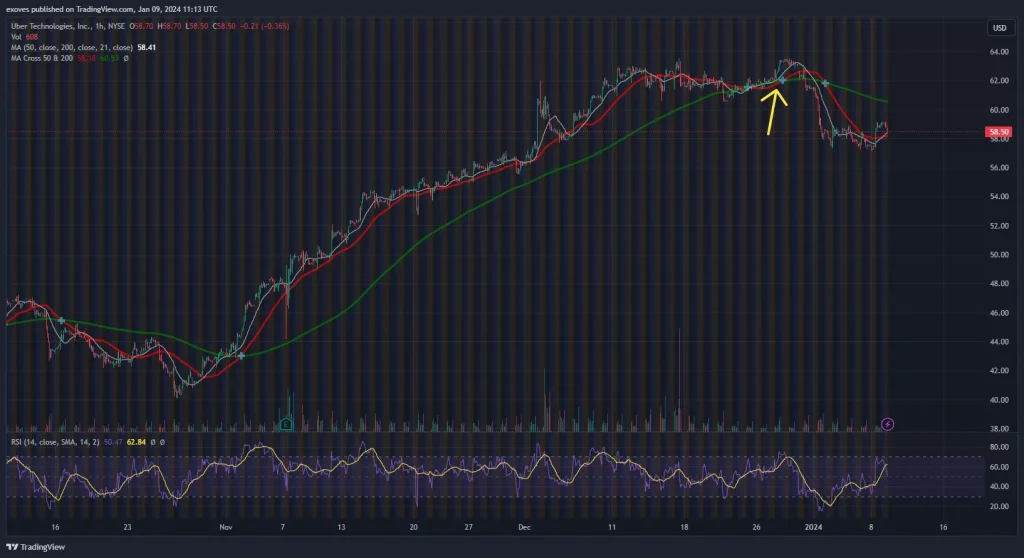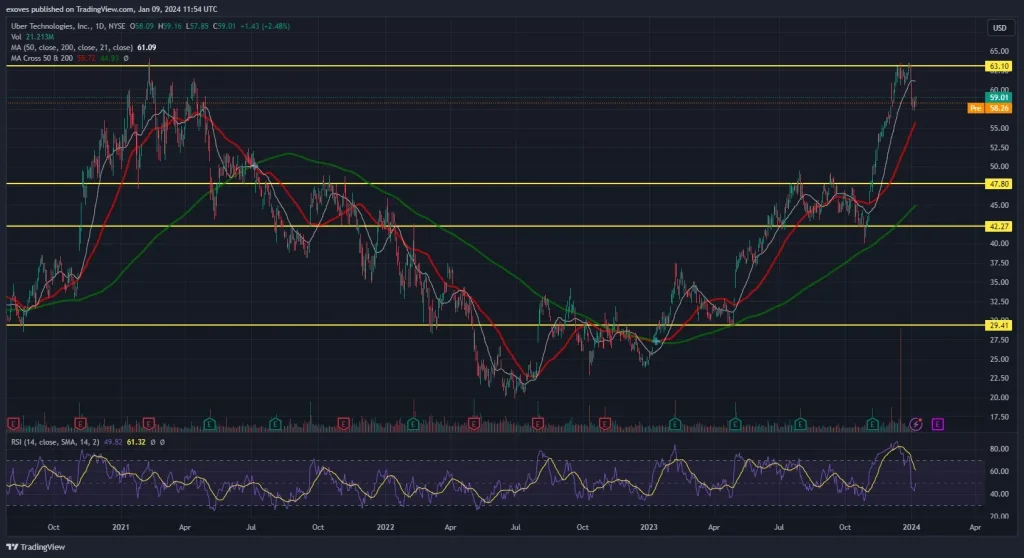Uber Technologies Inc (NYSE: UBER) and Tesla Inc (NASDAQ: TSLA) are planning an unlikely joint invasion of the land of the rising sun. Uber has just announced plans to deploy Tesla vehicles to enter Japan’s taxi market following a legal change allowing ridesharing in certain places at certain times for the first time ever. This latest development has long-term implications for the UBER stock forecast for a few different reasons.
For on thing, this partnership may surprise people who closely follow both companies since Uber announced plans in 2021 to create its own EVs starting in 2025. It also already has self-driving taxis, which are also electric, in three US cities. Not to mention, Tesla announced plans this year to start producing a fleet of robotaxis in 2024 that would compete directly with Uber.
Why are these two companies cooperating when they should be rivals and does this latest deal sign that Uber and Tesla will cooperate more in the future?
Why Uber isn’t in Japan
Currently, ridesharing is illegal in Japan. The Uber app in the country can only call a taxi, not offer ridesharing. The company never got the necessary permission to operate in Japan due to strong pressure from the taxi industry, which claimed that the introduction of ride-sharing would create unfair competition due to its lower prices. The National Federation of Automobile Transport Workers is a strong union representing about 40% of Japanese taxi drivers, so initially, the government gave into this union to avoid a strike and maintain political support. Despite this opposition, a severe shortage of taxi drivers caused the Japanese government to begin introducing ridesharing in parts of the country this April.
Japan’s rapidly aging population has caused the number of taxi drivers to fall by 20% since 2019. On top of this, Japan’s tourism sector is booming now that the country reopened to tourists in October 2022 following the pandemic. The number of tourists reached 2,561,500 in October of 2023, exceeding pre-pandemic levels, so Japan is quickly facing a situation where there are not enough taxis to meet demand – creating the perfect opportunity for Uber.
Toward Sustainable Transportation
Now Uber has the chance to bring their ride-sharing model to Japan, but why are they using Tesla EVs to do it?
As is, Uber has a plan to invest $800 million worldwide to support the shift to EVs. The goal is to become fully electric in the US and Canada by 2030 and globally by 2040. However, Uber’s decision is not because it is environmentally conscientious. Rather, the company is making this transition thanks to Canadian legislation setting the goal for selling only EVs by 2035, and US legislation subsidizing EVs. Japan also plans to fully convert to EVs by 2035, so its in Uber’s best interests to get ahead of the curve.
Besides this, Uber has also been facing pressure due to its role as a polluter. It’s estimated that in 2022, each mile traveled by a person in an Uber generated an average of 147 grams of CO2 in Europe and 322 grams of CO2 in the US and Canada. In response, Uber unveiled its plan to completely transition to EVs worldwide by 2040 which will make fares 20% more expensive than regular taxi fares in Japan. Ultimately, this transition to EVs is a positive sign for the UBER stock forecast but its not clear if the company will be able to meet its own deadlines.
A Growing Rivalry
Not only does Uber plan to transition to using only EVs, but it also plans to create its own EV, and maybe even a self-driving one. Uber has partnered with the London based EV maker, Arrival SA (NASDAQ: ARVL), to develop its own custom cars. The first phase of Uber’s plan is to transition its fleet to Arrival’s EV in London in 2025 before expanding globally.
But Uber isn’t just stopping with EV’s. In fact, its essential to the company’s continued survival and success that it capitalizes on autonomous vehicles. Transitioning to driverless cars will ultimately cut down on Uber’s costs from paying drivers. Currently, the Uber app offers autonomous vehicles in Phoenix, San Francisco, and Austin after partnering with Google’s self-driving car division, Waymoa. Uber has also started working with the startup Motional which is a joint venture between Hyundai Motor and the mobility technology company Aptiv PLC (NYSE: APTV).
The fact that Uber is now providing autonomous vehicles, albeit in limited places, and plans to have its own EVs puts it at loggerheads with Tesla. With 50% of the EV market and plans for its own autonomous vehicles, Tesla is already in competition with Uber but the stakes are about to become much higher considering that Tesla also has plans to launch its own robotaxi.
Tesla CEO, Elon Musk, said that he’s targeting production for the Robotaxi in 2024. However, the Robotaxi might not be a new car model, instead it could just be an existing Tesla with the company’s self-driving software installed. Musk also discussed the possibility of installing self-driving software so that cars can function as part of a ride-hailing network when the owners are not using them. So rather than just leave their car parked, the cars would act as Robotaxis and the profits would be split between Tesla and the car owners.
Since Tesla’s ride hailing network would be limited to just Tesla vehicles, there is no chance for integration between the two companies’ fleets. This presents an obstacle since Uber already has an established userbase and Tesla would need to persuade consumers to switch to its own app instead. Why would someone, with an Uber app already on their phone, download the Tesla app as well?
Compete or Cooperate?
In light of this competition between Tesla and Uber, it seems very strange that the two companies have apparently decided to put their rivalry aside and cooperate in Japan. It could just be the abrupt change in Japanese regulations giving Uber an opportunity too good to pass up despite not having the EVs to do so at the moment.
However, this doesn’t explain why the two companies have partnered before. Recently, Tesla has started selling its EVs to Uber drivers directly – through Uber no less! Tesla has even offered discounts for Uber drivers on their Model 3 and Model Y vehicles.
How can we explain this unexpected alliance? This could just be the result of Uber not being able to supply the amount of EVs promised in its transition plan and choosing to bridge the gap using Tesla instead. As for Tesla, this could just be a chance to test out the ride-hailing market using its vehicles and gain market visibility.
Given their overlapping interests, this could just be a partnership of convenience despite their growing rivalry. However, it seems like Uber has the most to lose from this partnership since using Tesla’s vehicles and investing in them only sets back its own plans for manufacturing vehicles.
Benefits from the Deal
But that’s not to say that Uber doesn’t get something out of the deal. It’s entry into the Japanese market is significant, since total revenue was projected to reach $2.56 billion in 2023, and is expected to hit $2.69 billion by 2028. The number of users is also projected to reach 14.28 million in 2028. In light of this market growth and low competition, Uber could capitalize on Japan’s ride-hailing market. Growing its share of the Japanese market could improve the UBER stock forecast for 2024 and beyond.
As for Tesla, it will benefit from the deal by getting more market visibility, as well as testing its vehicles in the ride-hailing market. Not to mention, Uber will be buying vehicles from Tesla although just 30 Tesla Model Ys initially, the order will increase to 100 in 2024.
Technical Analysis
But what does Uber’s entry into Japan mean for Uber stock?
UBER stock popped about 2.4% following news that Uber would be entering the Japanese market, but has dropped about 6.7% since the start of 2024. This pullback comes after UBER stock closed at $63.28 on December 27th – its highest closing price so far.

Looking at the daily chart, the RSI has dropped to 50 after becoming overbought. Bullish investors could add to their position in UBER stock on a retest of the MAs.

UBER Stock Forecast
While this expansion would add more customers and drivers to the Uber platform, it likely will not have an immediate or extremely significant impact yet. It will take time for current taxi drivers to adopt the Uber app, not to mention users as well. In light of this, investors are likely waiting to see whether Uber can capture a significant segment of the market.
Although investors and analysts are waiting to see what this expansion will yield, Uber’s CEO, Dara Khosrowshahi, is bullish saying that, the “Potential in Japan is enormous,” and that Japan is a very strategic market for Uber because of it’s large economy. Uber has already laid the groundwork for its expansion thanks to ties with some Japanese taxi companies. Currently its app is being used by taxi companies in about 20 cities. But ultimately, Uber’s goal its to get “every single taxi in Japan on our Uber app” according to Khosrowshahi.
Khosrowshahi is not wrong to be optimistic. New regulations have introduced an important opportunity for Uber and considering that Japanese taxi drivers reportedly work 17 to 19 hours per shift, Uber’s more flexible program could offer a compelling alternative.
Overall, this expansion marks an improvement in the UBER stock forecast, but it raises more questions about the platform’s long-term relationship with Tesla. Right now, it looks like the two companies are cooperating and competing simultaneously. They both have plans to encroach into each other’s territories, but were presented with a golden opportunity in Japan that forced them to become allies. Whatever happens next, this will be a very interesting relationship to keep an eye on in the coming years.
Disclaimer
Please visit and read our disclaimer here.









